Abstract
In neuronal networks, the changes of synaptic strength (or weight) performed by spike-timing-dependent plasticity (STDP) are hypothesized to give rise to functional network structure. This article investigates how this phenomenon occurs for the excitatory recurrent connections of a network with fixed input weights that is stimulated by external spike trains. We develop a theoretical framework based on the Poisson neuron model to analyze the interplay between the neuronal activity (firing rates and the spike-time correlations) and the learning dynamics, when the network is stimulated by correlated pools of homogeneous Poisson spike trains. STDP can lead to both a stabilization of all the neuron firing rates (homeostatic equilibrium) and a robust weight specialization. The pattern of specialization for the recurrent weights is determined by a relationship between the input firing-rate and correlation structures, the network topology, the STDP parameters and the synaptic response properties. We find conditions for feed-forward pathways or areas with strengthened self-feedback to emerge in an initially homogeneous recurrent network.
Similar content being viewed by others
References
Appleby PA, Elliott T (2006) Stable competitive dynamics emerge from multispike interactions in a stochastic model of spike-timing-dependent plasticity. Neural Comput 18(10): 2414–2464
Bi GQ, Poo MM (2001) Synaptic modification by correlated activity: Hebb’s postulate revisited. Annu Rev Neurosci 24: 139–166
Burkitt AN (2006) A review of the integrate-and-fire neuron model: I. Homogeneous synaptic input. Biol Cybern 95(1): 1–19
Burkitt AN, Meffin H, Grayden DB (2004) Spike-timing-dependent plasticity: the relationship to rate-based learning for models with weight dynamics determined by a stable fixed point. Neural Comput 16(5): 885–940
Burkitt AN, Gilson M, van Hemmen JL (2007) Spike-timing-dependent plasticity for neurons with recurrent connections. Biol Cybern 96(5): 533–546
Câteau H, Kitano K, Fukai T (2008) Interplay between a phase response curve and spike-timing-dependent plasticity leading to wireless clustering. Phys Rev E 77(5): 051909
Gerstner W, Kempter R, van Hemmen JL, Wagner H (1996) A neuronal learning rule for sub-millisecond temporal coding. Nature 383(6595): 76–78
Gilson M, Burkitt AN, Grayden DB, Thomas DA, van Hemmen JL (2009a) Emergence of network structure due to spike-timing-dependent plasticity in recurrent neuronal networks I: input selectivity–strengthening correlated input pathways. Biol Cybern 101(2): 81–102
Gilson M, Burkitt AN, Grayden DB, Thomas DA, van Hemmen JL (2009b) Emergence of network structure due to spike-timing-dependent plasticity in recurrent neuronal networks II: input selectivity–symmetry breaking. Biol Cybern 101(2): 103–114
Gilson M, Burkitt AN, Grayden DB, Thomas DA, van Hemmen JL (2009c) Emergence of network structure due to spike-timing-dependent plasticity in recurrent neuronal networks III: partially connected neurons driven by spontaneous activity. Biol Cybern doi:10.1007/s00422-009-0343-4
Gütig R, Aharonov R, Rotter S, Sompolinsky H (2003) Learning input correlations through nonlinear temporally asymmetric Hebbian plasticity. J Neurosci 23(9): 3697–3714
Hawkes AG (1971) Point spectra of some mutually exciting point processes. J Roy Stat Soc Ser B 33(3): 438–443
Hebb DO (1949) The organization of behavior: a neuropsychological theory. Wiley, New York
Iglesias J, Eriksson J, Grize F, Tomassini M, Villa A (2005) Dynamics of pruning in simulated large-scale spiking neural networks. Biosystems 79: 11–20
Izhikevich EM, Gally JA, Edelman GM (2004) Spike-timing dynamics of neuronal groups. Cereb Cortex 14: 933–944
Karbowski J, Ermentrout GB (2002) Synchrony arising from a balanced synaptic plasticity in a network of heterogeneous neural oscillators. Phys Rev E 65(3): 031902
Kempter R, Gerstner W, van Hemmen JL (1999) Hebbian learning and spiking neurons. Phys Rev E 59(4): 4498–4514
Lubenov EV, Siapas AG (2008) Decoupling through synchrony in neuronal circuits with propagation delays. Neuron 58(1): 118–131
Markram H, Lübke J, Frotscher M, Roth A, Sakmann B (1997) Physiology and anatomy of synaptic connections between thick tufted pyramidal neurones in the developing rat neocortex. J Physiol (Lond) 500(2): 409–440
Masuda N, Kori H (2007) Formation of feedforward networks and frequency synchrony by spike-timing-dependent plasticity. J Comput Neurosci 22(3): 327–345
Meffin H, Besson J, Burkitt AN, Grayden DB (2006) Learning the structure of correlated synaptic subgroups using stable and competitive spike-timing-dependent plasticity. Phys Rev E 73(4): 041911
Moreno-Bote R, Renart A, Parga N (2008) Theory of input spike auto-and cross-correlations and their effect on the response of spiking neurons. Neural Comput 20(7): 1651–1705
Morrison A, Aertsen A, Diesmann M (2007) Spike-timing-dependent plasticity in balanced random networks. Neural Comput 19(6): 1437–1467
Morrison A, Diesmann M, Gerstner W (2008) Phenomenological models of synaptic plasticity based on spike timing. Biol Cybern 98(6): 459–478
Pfister JP, Toyoizumi T, Barber D, Gerstner W (2006) Optimal spike-timing-dependent plasticity for precise action potential firing in supervised learning. Neural Comput 18(6): 1318–1348
Roberts PD (2004) Recurrent biological neuronal networks: the weak and noisy limit. Phys Rev E 69(3): 031910
van Hemmen JL (2001) Theory of synaptic plasticity. In: Moss F, Gielen S (eds) Handbook of biological physics, vol 4: Neuro-informatics and neural modelling. Elsevier, Amsterdam, pp 771–823
van Rossum MCW, Bi GQ, Turrigiano GG (2000) Stable Hebbian learning from spike timing-dependent plasticity. J Neurosci 20(23): 8812–8821
Senn W, Schneider M, Ruf B (2002) Activity-dependent development of axonal and dendritic delays, or, why synaptic transmission should be unreliable. Neural Comput 14(3): 583–619
Sjöström PJ, Turrigiano GG, Nelson SB (2001) Rate, timing, and cooperativity jointly determine cortical synaptic plasticity. Neuron 32(6): 1149–1164
Song S, Abbott LF (2001) Cortical development and remapping through spike timing-dependent plasticity. Neuron 32(2): 339–350
Toyoizumi T, Pfister JP, Aihara K, Gerstner W (2007) Optimality model of unsupervised spike-timing-dependent plasticity: synaptic memory and weight distribution. Neural Comput 19(3): 639–671
Author information
Authors and Affiliations
Corresponding author
Rights and permissions
About this article
Cite this article
Gilson, M., Burkitt, A.N., Grayden, D.B. et al. Emergence of network structure due to spike-timing-dependent plasticity in recurrent neuronal networks IV. Biol Cybern 101, 427–444 (2009). https://doi.org/10.1007/s00422-009-0346-1
Received:
Accepted:
Published:
Issue Date:
DOI: https://doi.org/10.1007/s00422-009-0346-1




